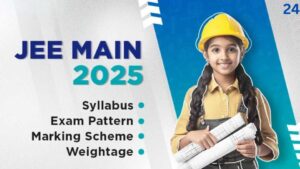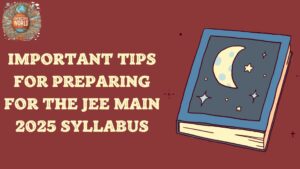The National Testing Agency (NTA) conducts the Joint Entrance Examination (JEE) Mains, a competitive engineering entrance examination in India. Every year, the exam is held for entrance to undergraduate engineering courses at the Indian Institutes of Technology (IITs), National Institutes of Technology (NITs), and other leading engineering institutions nationwide.
The NTA published the JEE Main 2025 syllabus on its official website, jeemain.nta.nic.in. The JEE Main 2025 dates are also out. So, NTA will conduct the JEE Mains 2025 in two sessions.
The JEE Main 2025 Paper 1 is from January 22, 23, 24, 28, and 29, 2025, in two shifts: First Shift (9 AM to 12 Noon) and Second Shift (3 PM to 6 PM). The Paper 2 will occur on January 30, 2025, from 3 to 6:30 PM. The JEE Main Admit Card 2025 will be published on January 20, 2025.
The JEE Main 2025 Syllabus evaluates an applicant’s aptitude and competency in mathematics, physics, and chemistry. The syllabus gets updated every year to reflect the most recent trends and breakthroughs in engineering and technology. Candidates studying for JEE Main 2025 require knowledge of the syllabus to perform well on the exam. Read the full article for more information regarding the JEE Main syllabus 2025.
Overview of JEE Main 2025 Exam Pattern

The NTA has made some exam pattern changes to all three papers – Paper 1 (BE/BTech), Paper 2A (BArch) and Paper 2B (BPlan). So, with respect to the new pattern, the JEE Main exam 2025 for Paper 1 Section B will not include any optional questions. Further, there will be only five questions for each subject and the candidate must answer all these questions.
Similarly, for the Mathematics section in Papers 2A and 2B, there would be no optional questions. For the detailed exam pattern, you can refer to the NTA’s official website.
Overview of JEE Main 2025 Syllabus

The JEE Main 2025 syllabus covers an extensive selection of physics, chemistry, and maths areas. Further, the examination follows the NCERT curriculum for Classes 11 and 12. This exam aims to assess students’ understanding, application, and problem-solving abilities in these areas. Hence, this ensures that they have enough preparation for the engineering entrance examination.
JEE Main Paper-1 (BE/B.Tech.) Syllabus
1. Mathematics:
The Mathematics syllabus is as follows:
| Unit | Topic |
| 1 | Sets
Relations and Functions |
| 2 | Complex Numbers
Quadratic Equations |
| 3 | Matrices and Determinants |
| 4 | Permutations and Combinations |
| 5 | Binomial Theorem and Its Simple Applications |
| 6 | Sequence and Series |
| 7 | Limit and Continuity
Differentiability |
| 8 | Integral Calculus |
| 9 | Differential Equations |
| 10 | Coordinate Geometry |
| 11 | Three-Dimensional Geometry |
| 12 | Vector Algebra |
| 13 | Statistics and Probability |
| 14 | Trigonometry |
2. Physics:
The JEE Main 2025 Syllabus for the Physics portion is as follows:
Section A – Theory
| Unit | Topic |
| 1 | Units and Measurement |
| 2 | Kinematics |
| 3 | Laws of Motion |
| 4 | Work, Energy, and Power |
| 5 | Rotational Motion |
| 6 | Gravitation |
| 7 | Properties of Solids and Liquids |
| 8 | Thermodynamics |
| 9 | Kinetic Theory of Gases |
| 10 | Oscillations and Waves |
| 11 | Electrostatics |
| 12 | Current Electricity |
| 13 | Magnetic Effects of Current and Magnetism |
| 14 | Electromagnetic Induction and Alternating Currents |
| 15 | Electromagnetic Waves |
| 16 | Optics |
| 17 | Dual Nature of Matter and Radiation |
| 18 | Atoms and Nuclei |
| 19 | Electronic Devices |
Section B – Experiment Skills
| S. No. | Experiment |
| 1 | Vernier Caliper -its use to measure the internal and external diameter and depth of a vessel. |
| 2 | Screw gauge-its use to determine the thickness/ diameter of thin sheet/wire. |
| 3 | Simple Pendulum-dissipation of energy by plotting a graph between the square of amplitude and time. |
| 4 | Metre Scale – the mass of a given object by the principle of moments. |
| 5 | Young’s modulus of elasticity of the material of a metallic wire. |
| 6 | Surface tension of water by capillary rise and effect of detergents. |
| 7 | Coefficient of Viscosity of a given viscous liquid by measuring the terminal velocity of a given spherical body. |
| 8 | Speed of sound in air at room temperature using a resonance tube. |
| 9 | Specific heat capacity of a given (i) solid and (ii) liquid by method of mixtures. |
| 10 | The resistivity of the material of a given wire using a metre bridge. |
| 11 | The resistance of a given wire using Ohm’s law. |
| 12 | Resistance and figure of merit of a galvanometer by half deflection method. |
| 13 | The focal length of; (i) Convex mirror (ii) Concave mirror, and (ii) Convex lens, using the parallax method. |
| 14 | The plot of the angle of deviation vs angle of incidence for a triangular prism. |
| 15 | The refractive index of a glass slab using a travelling microscope. |
| 16 | Characteristic curves of a p-n junction diode in forward and reverse bias. |
| 17 | Characteristic curves of a Zener diode and finding reverse breakdown voltage. |
| 18 | Identification of Diode. LED, Resistor. A capacitor from a mixed collection of such items. |
3. Chemistry:
Now, let’s have a look at the subjects of Chemistry:
Section A: Theory
| Unit | Physical Chemistry |
| 1 | Some Basic Concepts in Chemistry |
| 2 | Atomic Structure |
| 3 | Chemical Bonding and Molecular Structure |
| 4 | Chemical Thermodynamics |
| 5 | Solutions |
| 6 | Equilibrium |
| 7 | Redox Reactions and
Electrochemistry |
| 8 | Chemical Kinetics |
| Inorganic Chemistry | |
| 9 | Classification of Elements and Periodicity in Properties |
| 10 | P- Block Elements |
| 11 | d-Block and f-Block Elements |
| 12 | Coordination Compounds |
| Organic Chemistry | |
| 13 | Purification and Characterisation of Organic Compounds |
| 14 | Some Basic Principles of Organic Chemistry |
| 15 | Hydrocarbons |
| 16 | Organic Compounds Containing Halogens |
| 17 | Organic Compounds Containing Oxygen |
| 18 | Organic Compounds Containing Nitrogen |
| 19 | Biomolecules |
Sections B: Experiment Skills
| Principles Related to Practical Chemistry | |
| 20 (i) | Detection of extra elements (Nitrogen, Sulphur, halogens) in organic compounds; |
| 20 (ii) | Detection of the following functional groups; hydroxyl (alcoholic and phenolic), carbonyl (aldehyde and ketones) carboxyl, and amino groups in organic compounds |
| 20 (iii) | The chemistry involved in the preparation of the following: l Inorganic compounds; Mohr’s salt, potash alum. l Organic compounds: Acetanilide, p-nitro acetanilide, aniline yellow, iodoform |
| 20 (iv) | The chemistry involved in the titrimetric exercises – Acids, bases, and the use of indicators, oxalic-acid vs KMnO4, Mohr’s salt vs KMnO4 |
| 20 (v) | Chemical principles involved in the qualitative salt analysis: Cations – Pb2+, Cu2+, Al3+, Fe3+, Zn2+, Ni2+, Ca2+, Ba2+, Mg2+, NH4+ Anions- CO32−, S2-,SO42−,NO3-, NO2-, Cl-, Br-, I- (Insoluble salts excluded) |
| 20 (vi) | Chemical principles involved in the following experiments: 1. Enthalpy of solution of CuSO4 2. Enthalpy of neutralization of strong acid and strong base. 3. Preparation of lyophilic and lyophobic sols. 4. Kinetic study of the reaction of iodide ions with hydrogen peroxide at room temperature. |
JEE Main 2025 Syllabus for Paper 2A (B.Arch)
The JEE Main Syllabus for B. Arch comprises Mathematics, Drawing, and General Aptitude. Here you can find the subject-wise syllabus:
1. Mathematics
The syllabus for Mathematics is similar to that of the JEE Main Paper-1 Syllabus (B.E./B.Tech.)
2. General Aptitude Syllabus:
| Section | Topics |
| Aptitude: Part-I | • Awareness of Places, Materials, Objects, Persons, and Places. • Visualising different sides of three-dimensional Objects. • Visualising 3D objects from 2D drawings. • Analytical Reasoning Mental Ability (Verbal, Numerical, and Visual). |
| Aptitude: Part-II | • 3D – perception: Understanding and appreciation of scale and proportion of building elements. forms, Objects. harmony, texture, colour. and contrast
• Drawing and designing abstract and geometrical shapes and patterns in pencil • Transformation of forms in both 20 and 3D union, development of volumes & surfaces, subtraction, rotation, elevations, and Generation of plans. and 3D views of objects. • Creating 3D & 2D Compositions using given forms and shapes. • Sketching of scenes and activities from memory of urban landscape (public space, market, festivals, street scenes, monuments, recreational spaces, etc.). landscape (river fronts, jungles, trees, plants, etc.), and rural life. |
3. Drawing:
Sketching of scenes and activities from memory of urbanscape (public space, market, festivals, street scenes, monuments, recreational spaces, etc.). landscape (riverfronts. Jungle. Gardens, trees. Plants, etc.) and rural life. These drawings will be on drawing sheet.
JEE Main 2025 Syllabus for Paper 2B (B.Plan)
The syllabus for Paper 2B (B.Plan) includes Mathematics, General Aptitude, and Planning. Mathematics and General Aptitude syllabus is same as the B.Arch.
| Units | Topics |
| Unit-1 (General Awareness) | General knowledge questions and knowledge about prominent cities, development issues, government programs, etc. |
| Unit-2 (Social Science) | The idea of Nationalism, nationalism in India, the pre-modern world, 19th-century global economy, colonialism, and colonial cities, industrialization, resources, and development, types of resources, agriculture, water, mineral resources, industries, national economy; Human Settlements. Power-sharing, federalism, democracy, political parties, The constitution of India. Economic development- economic sectors/ globalization, the concept of development, poverty; Population structure, social exclusion, and inequality, urbanization, rural development, colonial cities. |
| Unit-3 (Thinking Skills) | Comprehension (unseen passage); map reading skills, scale, distance, direction, area, etc. Critical Reasoning; Understanding of charts, graphs, and tables; Basic concepts of Statistics & Quantitative Reasoning. |
Important Tips for Preparing for the JEE Main 2025 Syllabus

- Start early: Acquaint yourself with the test’s structure and subject matter. This will assist you in scheduling your study time and determining your knowledge gaps.
- Understand the syllabus: Understand the concepts covered in the JEE Mains syllabus. This will help you concentrate your study efforts and give you an idea of the subjects covered in the examination.
- Practice, practice, practice: You can become familiar with the exam structure and the different kinds of questions you will face the more you practice.
- Get ample rest: While studying for the JEE Mains exam, getting adequate sleep is necessary. Sleep deprivation can affect memory, focus, and general test performance.
- Time Management: Proper time management is crucial for the JEE Mains exam because it is a timed test. Hence, practice time management to complete the entire test within the allocated time.
Conclusion
The JEE Mains exam is a crucial step for every aspirant willing to gain admittance into one of India’s top colleges/institutions. Get familiar with the JEE Main 2025 Syllabus and start your preparation. Good luck!

